Advertisement
Hand Mudras 101: What They Are, How To Use Them + 13 Mudras To Try

If you're into yoga or meditation, you've probably done plenty of downward dogs and warrior poses, or perhaps tried different styles of meditation—but have you ever incorporated hand mudras into your practice?
Even if you haven't, you can probably picture the classic gyan mudra (or chin mudra), commonly displayed by meditators. And if you want to try it (or other mudras), yourself—you're in luck.
Here's what hand mudras are all about, plus 13 to use in your meditation and/or yoga practice.
What are hand mudras?
Mudra is an ancient Sanskrit term meaning "gesture," "seal," or "mark." We use mudras in yoga and meditation to bring and foster a greater sense of awareness to certain energetic fields within the subtle body. Subsequently, mudras can further help us meditate and open up our seven main chakras.
The practice of these gestures and seals channel the flow of prana life force, and there are three categories: hand or hasta mudras, body (kaya) mudras, and consciousness (citta) mudras.
In Ayurvedic and yogic traditions, the body is believed to be comprised of five elements, which are ideally balanced in the body. Hand mudras, specifically, relate to the elemental property of the five fingers, which are as follows:
- Thumb: Fire
- Index finger: Air
- Middle finger: Ether or space
- Ring finger: Earth
- Pinky finger: Water
You can incorporate different mudras into different yoga poses or meditations depending on the benefits of that specific mudra. Some are more suited for focus and concentration, for example, while others are better for boosting energy and vitality.
13 hand mudras
Gyan mudra (AKA Chin mudra)
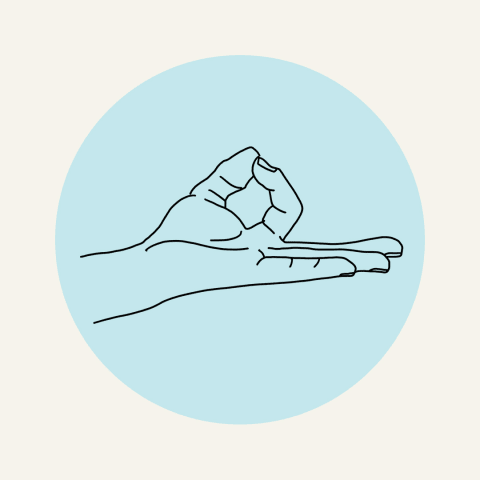
A gesture of wisdom, understanding, and knowledge, the gyan mudra symbolizes focus and transformation. It's also great for grounding and supporting the root chakra.
How to do it:
Make a circle by bringing your thumb and index fingertips to touch and leaving your other three fingers extended. With both hands in the gyan mudra, rest them on your knees, with your palms facing up.
Prithvi mudra
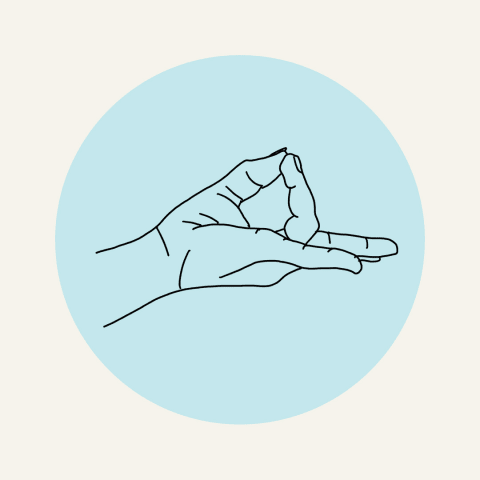
Relating to the element of Earth, the privthi mudra is grounding and stabilizing, improving your stamina as well. "Prithvi" actually means Earth in Sanskrit, and as such, this mudra is a great one for working with your root chakra.
How to do it:
Bring your ring finger to gently touch your thumb, extending your three other fingers outward. With both hands in the privthi mudra, bring your hands to your knees with the palms facing up.
Varun mudra
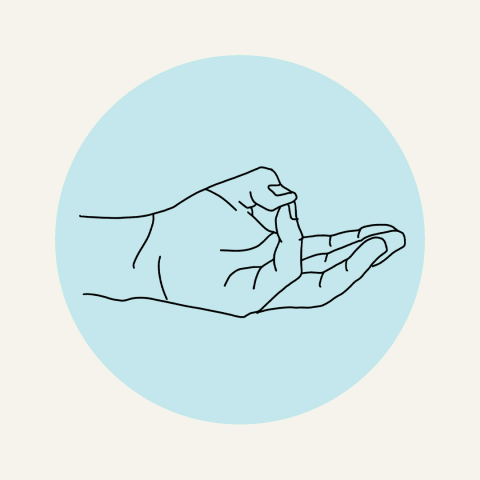
With the pinky finger representing the element of water, this mudra connects you to the water in your own body, as well as the sacral chakra. Water is life—and it must balanced within us in order for us to feel our best. Use this mudra to balance your literal or emotional waters, and work with your sacral chakra.
How to do it:
Bring your thumb and pinky finger together gently with the palms facing up. Try to keep your fingers extended but relaxed. (They'll naturally curl a bit, which is OK.) Like all mudras, use both hands.
Prana mudra
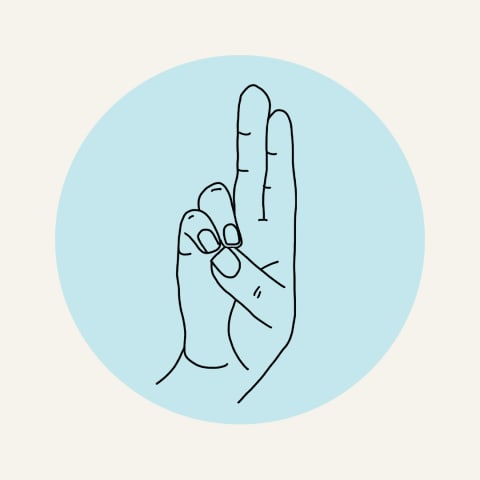
"Prana" in Sanskrit means "breath," but also "life force," and that's exactly what this mudra is about. It enlivens your energy and vitality from the root chakra, spreading it all throughout your system. With the ring and pinky fingers relating to Earth and water, respectively, this mudra increase those elements in the body while quelling internal fire.
How to do it:
Bring the tips of your pink and ring fingers to gently touch the tip of your thumb, extending your index and middle finger outwards on both hands. Have the palms facing up.
Apana mudra
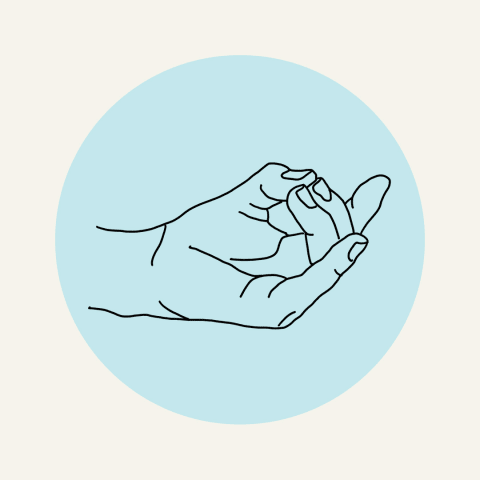
The apana mudra is also known as the "purification mudra," believed to help purify the body. With the middle and ring finger relating to ether (or space) and Earth, respectively, this mudra can help bring down fire or "pitta" in the body for more balance.
How to do it
Gentle bring the tips of your middle and ring finger to touch the tip of your thumb on both hands. Extend your index and pinky finger outward, and place your hands on your knees with the palms facing up.
Vayu mudra
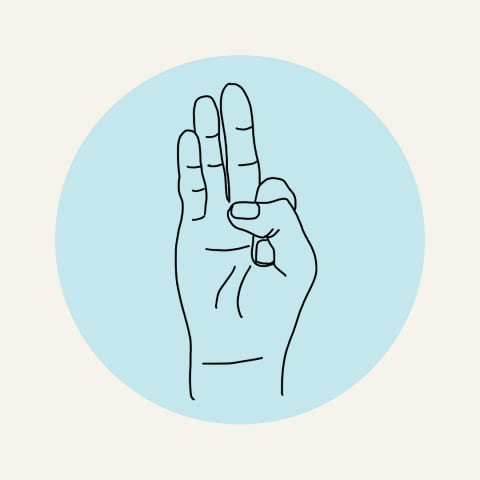
If you need to calm down, the vayu mudra isn't one to miss. With the thumb (which relates to fire) pressing the index finger (air), this mudra calms the mind and encourages emotional processing and release. It's also excellent for working with your heart chakra.
How to do it:
Curl your index finger down to the fleshy base of your thumb and cross your thumb on top to hold it down. Extend your middle, ring, and pinky fingers out with the palms facing up, placing your hands on your knees.
Shunya mudra
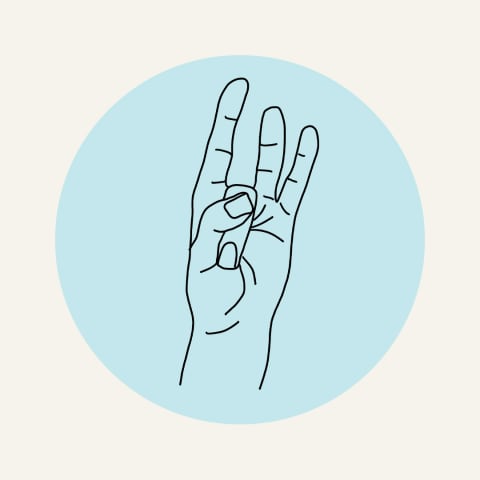
A mudra for relieving feelings of emptiness and/or numbness, the shunya mudra decreases the element of ether/space, which allows the other elements to balance in the body. Too much ether can result in feeling disconnected, and this mudra brings you back to your body and emotions.
How to do it:
Curl your middle finger down to the fleshy base of your thumb and place your thumb on top to hold it down gently. Extend your index, ring, and pinky fingers out with the palms facing up. Perform the mudra with both hands, placing them on your knees.
Surya mudra
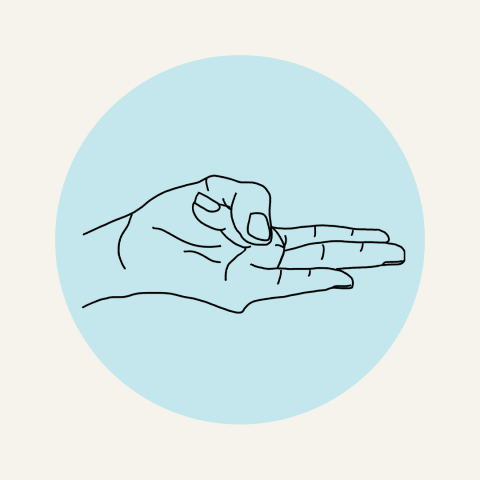
Connecting the elements of fire and Earth, the surya mudra increases heat in the body, unlike some of the other ones on this list, which help quell it. Times you might want to turn up the heat include, for instance, when you need an energy boost or want to improve your strength. This is also a great mudra for the solar plexus chakra—"surya" does translate to "Sun," after all.)
How to do it:
Curl your ring finger down to the fleshy base of your thumb, extending your index, middle, and pinky fingers outward. Have both hands placed on your knees with the palms facing up.
Adi mudra
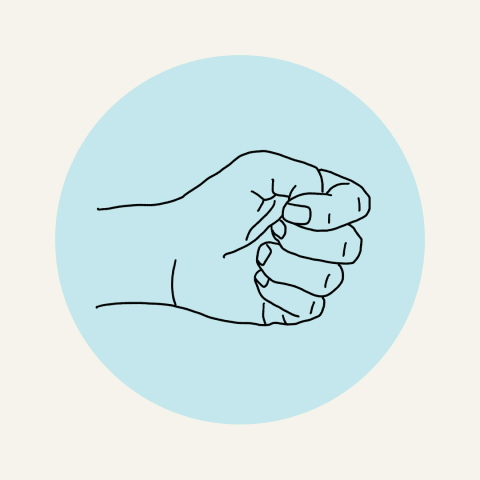
This mudra is way more than just making a fist—it can help calm your nervous system, boost oxygen flow, and even increase the breath capacity of your lungs. It's also thought to help increase concentration, making it excellent for the third eye and crown chakras.
How to do it:
Curl your thumb in towards your palm, and curl your other four fingers around it to hold it down. Placing both hands on your knees, have the palms facing up.
Anjali mudra
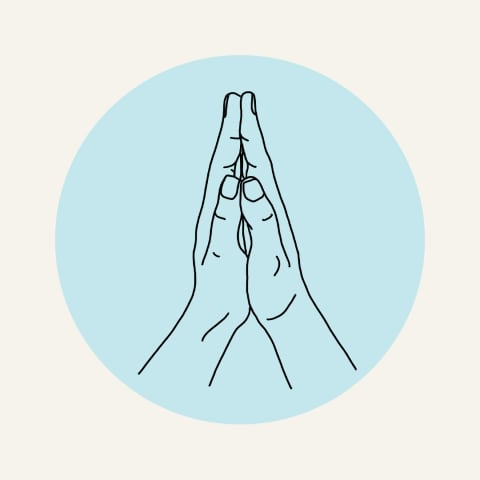
Whether you call it "hands to prayer," "hands at heart center," or in this case, the anjali mudra, this divine salute is a gesture of peace, gratitude, and humility. It's commonly used in greetings and prayer, making it an excellent mudra to thank those watching out for you in life and express gratitude for a teacher or lesson. but it can also be incorporated into your yoga and meditation practice for balance and concentration.
How to do it:
Bring your palms together in prayer and place the tips of your thumbs to your heart so that your arms run straight along your chest.
Hakini mudra
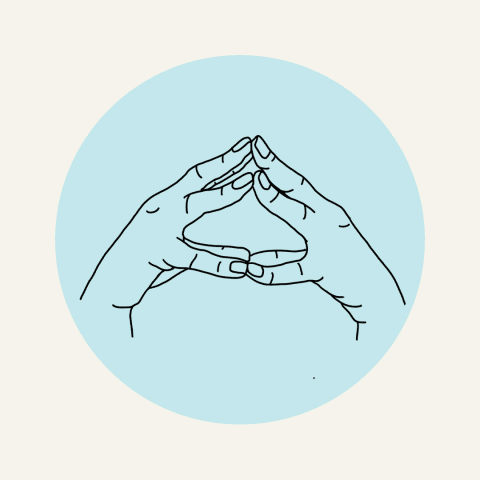
The hakini mudra is thought to connect the hemispheres of the brain, aiding in concentration as well as mental clarity, plus uniting your logical and intuitive minds. It can also be used to communicate and connect with your spirit guides, perfect for when you need to ask for assistance or share a concern with your spiritual role models or guardian angels. The mental nature of this mudra makes it well suited for the third eye chakra, too.
How to do it:
Touch all of your fingertips gently together to create a triangle. This mudra can be held up to your chest with the thumbs facing down, or down by your abdomen with the thumbs facing up, depending on which is more comfortable for you in that moment.
Shambhala mudra
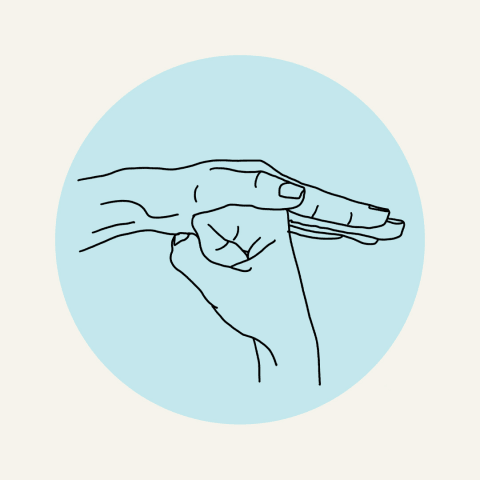
The Shield of Shambhala mudra, also commonly referred to just as the shambhala mudra, is exactly what it sounds like: a shield. Shambhala is a mythical kingdom in which all of its citizens have achieved enlightment, and this mudra is thought to cultivate that enlightenment within you. The "shield" in its namesake is a shielf from negativity and clouded thinking.
How to do it:
This mudra is traditionally performed with opposite hands depending on your sex.
For females, make a fist with your right hand, palm facing down, and place it against your left palm. Hold your hands in front of your abdomen, between your belly button and chest (roughly in line with the bottom of your lowest rib.)
For males, just switch the hands, forming a first with your left hand and pressing it against your right palm.
Dhyana mudra
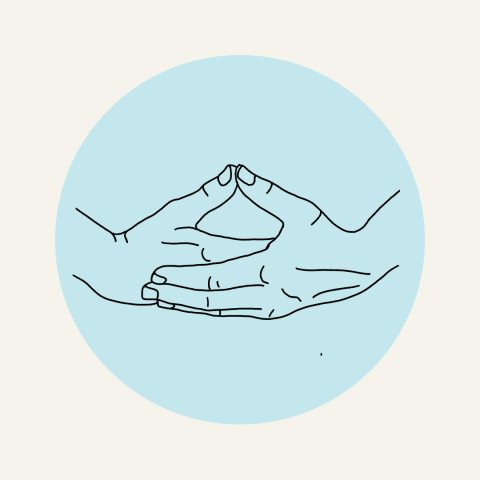
If this mudra looks familiar, it's likely because a large majority of the Buddha statues you see will depict the Buddha using it—and for good reason! "Dhyana" is actually the Sanskrit word for meditation, and this is an easy hand position to hold if you're meditating for extended periods. It's primarily used in this way, encouraging deeper meditations and inner reflection.
How to do it:
To do this mudra, simply place your right hand on top of your left, overlapping your fingers and bringing your thumbs to touch gentle. Hold your hands in your lap as you sit for meditation.
FAQs:
What are the 5 mudras?
The five mudras that relate to the five elements are: gyan mudra, prithvi mudra, prana mudra, surya mudra, varun mudra, and vayu mudra.
Do hand mudras really work?
Yes, hand mudras are a long standing practice in yogic culture, and work best when paired with other yogic lifestyle habits like an asana practice, breathwork, and meditation.
Which mudra is more powerful?
All of the mudras are powerful in their own ways—it all depends on the benefits you're looking for.
The takeaway
Whether you're new to yoga and meditation or you're looking to deepen your existing practice, hand mudras might be just what you're missing. There are literally hundreds to choose from, but this starter pack of the more common ones should give you a good sense of how mudras work—so you can start experiencing the benefits for yourself.
Watch Next
Enjoy some of our favorite clips from classes
Enjoy some of our favorite clips from classes
What Is Meditation?
Mindfulness/Spirituality | Light Watkins
Box Breathing
Mindfulness/Spirituality | Gwen Dittmar
What Breathwork Can Address
Mindfulness/Spirituality | Gwen Dittmar
The 8 Limbs of Yoga - What is Asana?
Yoga | Caley Alyssa
Two Standing Postures to Open Up Tight Hips
Yoga | Caley Alyssa
How Plants Can Optimize Athletic Performance
Nutrition | Rich Roll
What to Eat Before a Workout
Nutrition | Rich Roll
How Ayurveda Helps Us Navigate Modern Life
Nutrition | Sahara Rose
Messages About Love & Relationships
Love & Relationships | Esther Perel
Love Languages
Love & Relationships | Esther Perel

















